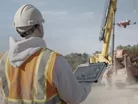Five valuable business lessons learned about drones in mining and aggregates

What will be the role of drones in the mining industry?
We’ve certainly asked the question before (CEO & Founder of Airware speaks exclusively to Mining Global) and we are certainly not the only ones in the industry doing the asking.
More and more companies, both large scale mining operators and drone technology solutions providers are spending more and more time and money into enabling the benefits of UAV technology in the mining industry.
BZ Media has just released its whitepaper “Five valuable business lessons learned about drones in mining and aggregates” commissioned by Skylogic Research.
So, let’s take a closer look.
Cost efficiencies are just the start of drone benefits
A quote that can be used as the major argument for the use of drones; “it is simply a more cost-effective method than traditional mapping and surveying approaches.”
Drones quite simply do not require the same level of maintenance and running costs as a manned aircraft. This does not mean there are no costs involved, but the costs lie in the initial procurement of the technology.
“Drones and the data from drones offer huge advantages in every part of the mining and aggregate production life cycle, including exploration, planning/permitting, operations and reclamation,” says the report.
And it’s true.
Airware (as mentioned above) is a major player on this front, specifically in ‘telematics; - the data of equipment. The company’s solutions allow companies to access critical information faster and improve operational efficiencies, allowing better decisions,
Using drones should be part of an overall effort to digitise planning operations
“Drone data needs to be seen as a digital asset that must be properly managed. In fact, drones provide a tremendous amount of data, and you need to be ready for managing it.”
Digitisation is a term that reverberates across most modern industries. Mining, is an industry that is lagging on this front. Ask anyone and they’ll tell you the same – mining over the last few years just hasn’t had the same level of technological growth as say, construction.
The report even states that mining and aggregate organisation “make the transition from traditional methods to technology enabled business processes,”
Drone technology is but one of the new technology enabled business processes, but with drones comes drone data, and lots of it. Mine operators should take this into consideration when enabling drone solutions into operations, drone data is an asset that must align with business objectives and be handled efficiently – otherwise there will be too much data and not enough worth.
It pays to do your homework on drone data solutions
Kind of goes without saying this one. There are both major benefits to drone technology, and major challenges to drone technology. A drone data solution will not be the complete package, the easy ride to success and profitability. Companies must allow for a time of learning, bedding in the new technology, both from a technical standpoint and from an operational behind the scenes one.
One thing to always consider, not all drone solutions are designed and built with a specific mining operation in mind. Some will be more suitable than others, but very rarely will they be the complete package. Sure, you can get a drone that gives you an amazing survey map of your entire operation, but what happens next is up to you, how do you use that data?
“We think it’s best to understand that there are three parts to the equation, the drone, the sensor and the data platform. All three should be tightly coupled as an end to end solution,”
So, to sum up, mining companies need to research what they need and research what’s out there. Luckily, there’s a report on that to: http://droneanalyst.com/2016/10/08/5-tips-for-evaluating-online-drone-data-services/
Calculationg ROI is worth the effort
This kind of feels like a no brainer.
Alas, this is the mining industry, and nothing is ever that simple.
“One could argue that, to understand the value of any new technology, you should calculate the achieved cost savings or inventory turnover. But in most cases, a mining technology is an integrated part of a larger system (for example, the software that controls the auto-steer on a hauler) so it’s more difficult to show cause and effect”
The report actually lists four key areas of a ROI impact study when looking to invest in drone technology solutions:
Accuracy of surveys and inventory
Cost of data acquisition
Safety and risk mitigation
Timeliness and frequency of reporting
You need a license to fly
A mining operator can’t just purchase a drone solution then send it out into the sky that very same day. Like flying and driving, there’s going to be a license involved. The U.S has actually incorporated the use of a UAV into its aviation laws, with the FAA publishing a number of documents that will assist businesses seeking compliance. You can access those here | http://dronelife.com/2016/08/23/faa-publishes-guidance-info-advance-part-107-taking-effect/
The big takeaway here really is, read. Study the laws, the regulations, so that a mining operation can effectively utilise drone technology and avoid any nasty discrepancies which could end up costing thousands if not millions in legal fees as a consequence.



